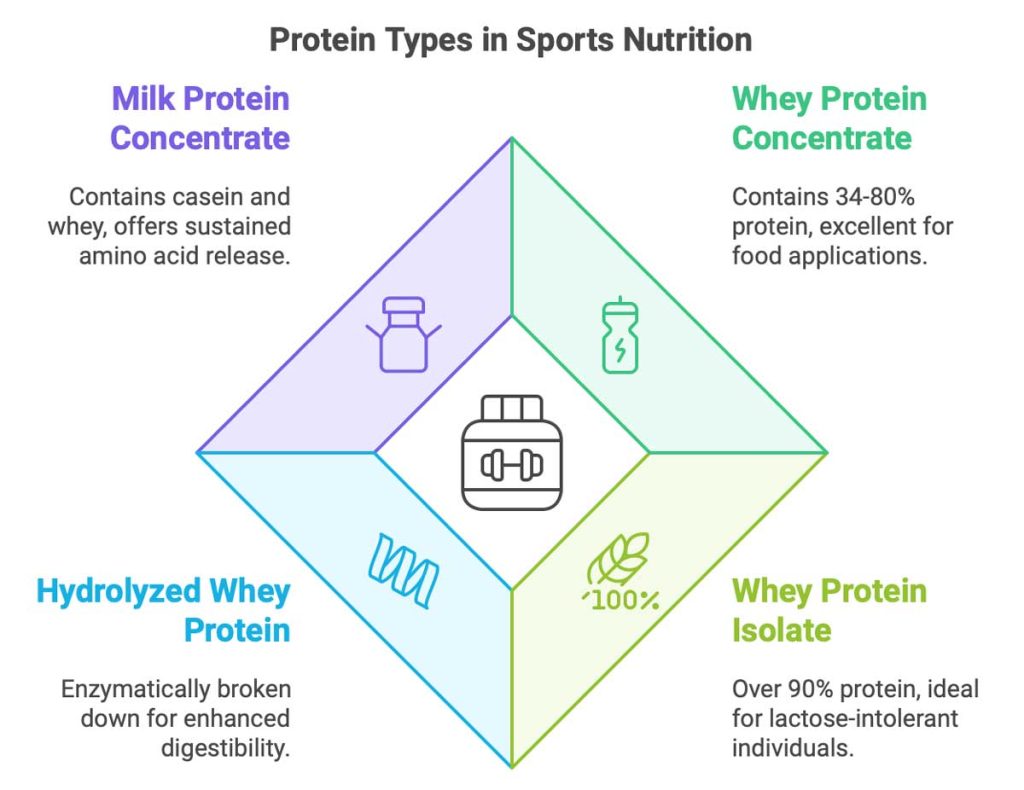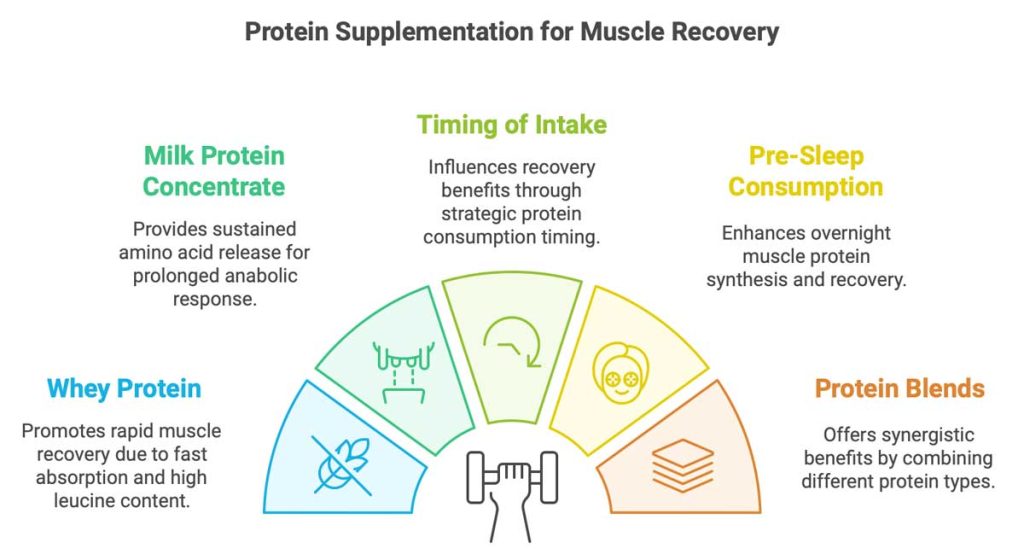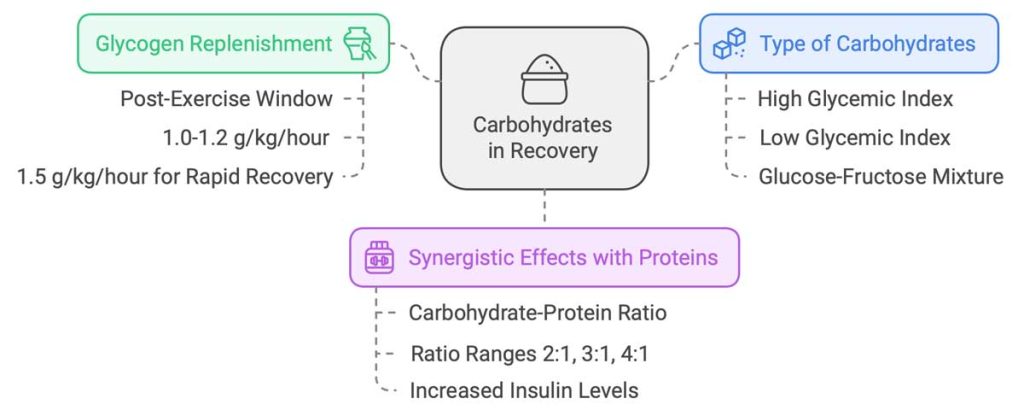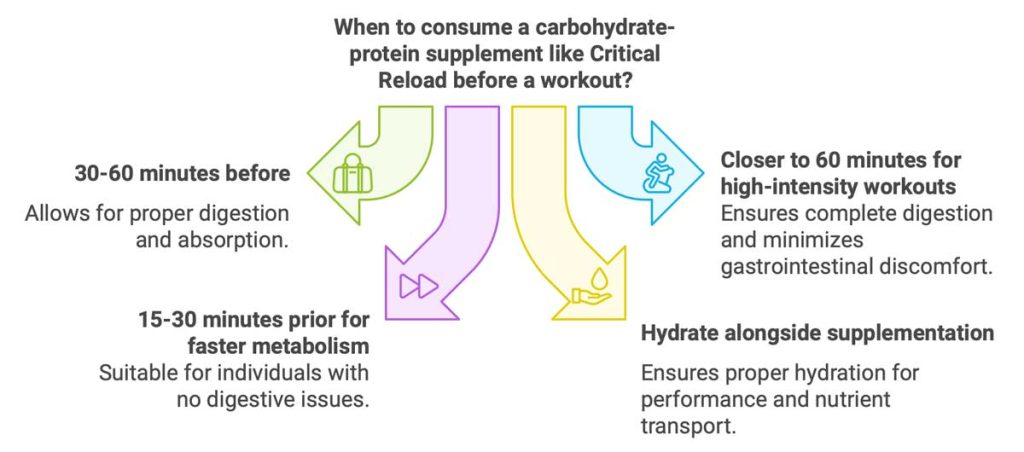Combining different protein types and carbohydrates in post-workout nutrition can play a vital role in supporting muscle recovery and enhancing performance. A well-designed blend of fast- and slow-digesting proteins, paired with complementary carbohydrates, helps boost muscle protein synthesis, extend anabolic responses, and balance insulin levels, offering a comprehensive approach to optimizing post-exercise recovery for athletes and fitness enthusiasts.
Listen Along: Dive deeper into the science of nutrition for high school athletes with this podcast episode that complements the information in this article. Hear insights from experts, actionable tips, and how Critical Reload can help your program excel in recovery and performance. 🎧💪
Types of Proteins in Sports Nutrition
Whey protein concentrate (WPC), hydrolyzed whey, whey protein isolate (WPI), and milk protein concentrate (MPC) differ in their composition, processing methods, and functional properties, which can impact their effectiveness in various applications, including sports nutrition and food products.
Whey protein concentrate (WPC) typically contains 34-80% protein, with the remainder consisting of lactose, fat, and minerals (Luck et al., 2013). It retains more of the native milk components, which can contribute to its flavor and functional properties. WPC has excellent foaming and gelation properties, making it suitable for various food applications.
Whey protein isolate (WPI) undergoes further processing to remove most non-protein components, resulting in a protein content of 90% or higher. WPI has lower fat and lactose content compared to WPC, making it a preferred choice for individuals with lactose intolerance or those seeking a purer protein source (Wang et al., 2024).
Hydrolyzed whey protein (HWP) is produced by enzymatically breaking down the protein chains into smaller peptides. This process can enhance digestibility and reduce allergenicity. HWP has been shown to improve heat stability in specific applications and may have faster absorption rates than intact proteins (Kaur et al., 2023).
Milk protein concentrate (MPC) contains casein and whey proteins in the same ratio found in milk (approximately 80% casein and 20% whey). MPC has different functional properties than whey proteins alone, including better emulsification and water-holding capacity (Khiabanian et al., 2022). It provides a more sustained release of amino acids due to the slower digestion of casein, which can be beneficial for prolonged muscle protein synthesis (Ren et al., 2021).

Muscle Protein Synthesis: Short-Term vs. Long-Term Benefits
Regarding muscle protein synthesis stimulation, whey protein (particularly WPI and hydrolyzed whey) is more effective than milk protein in the short term due to its rapid absorption and high leucine content (Sharp et al., 2018). However, milk protein may provide a more prolonged anabolic response due to the combination of fast-digesting whey and slow-digesting casein (Ren et al., 2021).
For sports nutrition applications, the choice of protein type depends on the specific goals. Whey proteins are often preferred for immediate post-exercise recovery due to their rapid absorption. In contrast, milk protein or a blend of whey and casein may be more suitable for sustained muscle protein synthesis and overall daily protein intake (Sharp et al., 2018).
Muscle Recovery Benefits Of Protein
Protein supplementation is crucial in muscle recovery, offering several benefits that can enhance athletic performance and overall muscle health. The type and timing of protein intake can significantly impact recovery outcomes.
Whey protein, particularly whey protein isolate (WPI) and hydrolyzed whey, is highly effective in promoting muscle recovery due to its rapid absorption and high leucine content (Wang et al., 2024; Sharp et al., 2018). These properties stimulate muscle protein synthesis (MPS) more quickly than other protein sources, making whey an excellent choice for immediate post-exercise recovery (Kaur et al., 2023).
However, milk protein concentrate (MPC), which contains whey and casein proteins, offers a more prolonged anabolic response. The combination of fast-digesting whey and slow-digesting casein in MPC provides a sustained release of amino acids, potentially benefiting muscle recovery over a longer period (Ren et al., 2021; Qin et al., 2021).
Studies have demonstrated that protein supplementation can reduce markers of muscle damage and soreness following intense exercise. For instance, whey protein supplementation has been shown to attenuate increases in creatine kinase (CK) levels, a marker of muscle damage, 24 hours post-exercise compared to placebo or plant-based proteins (Spoelder et al., 2023). This suggests that animal-based proteins like whey may more effectively mitigate exercise-induced muscle damage.

Timing and Reducing Muscle Damage
The timing of protein intake also influences recovery benefits. While the immediate post-exercise “anabolic window” concept has been challenged, consuming protein within a broader timeframe (up to 5-6 hours post-exercise) can still effectively support muscle recovery (Millard-Stafford et al., 2008). Additionally, pre-sleep protein consumption, particularly casein protein, has emerged to enhance overnight muscle protein synthesis and recovery (Bendtsen et al., 2019).
Interestingly, the combination of different protein types may offer synergistic benefits. For example, blends of whey and casein proteins, as found in some recovery shakes, can provide immediate and sustained amino acid availability, potentially optimizing the overall recovery process (Kaur et al., 2023).
The Role of Carbohydrates in Recovery
Carbohydrates are crucial in post-exercise recovery, particularly in replenishing glycogen stores and supporting protein synthesis. The carbohydrate intake type, amount, and timing can significantly impact recovery outcomes.
Immediately after exercise, muscle cells are highly sensitive to insulin and more efficient at absorbing glucose. This creates an optimal window for glycogen resynthesis. Consuming 1.0-1.2 g/kg body weight of carbohydrates per hour for the first 4-6 hours post-exercise can maximize glycogen replenishment (Millard-Stafford et al., 2008). For rapid recovery, especially when there are less than 8 hours between training sessions, higher intakes of up to 1.5 g/kg/hour may be beneficial.
Optimizing Carbohydrate Intake for Recovery
The type of carbohydrate consumed also matters. High glycemic index (GI) carbohydrates like maltodextrin can lead to faster glycogen resynthesis than low GI options. However, a combination of different carbohydrates may offer advantages. For instance, a mixture of glucose and fructose has been shown to enhance liver glycogen synthesis more effectively than glucose alone (Vasiliauskaite et al., 2023).
Carbohydrates also play a synergistic role in recovery, as do proteins. Adding carbohydrates to protein supplements can enhance muscle protein synthesis by increasing insulin levels, which promotes amino acid uptake and protein synthesis (Millard-Stafford et al., 2008). A carbohydrate-to-protein ratio of 3:1 or 4:1 is often recommended for optimal recovery.
For endurance athletes, carbohydrate intake during recovery can significantly impact subsequent performance. During recovery, athletes consuming a fructose-maltodextrin mixture have demonstrated greater exercise capacity in a second bout of endurance exercise than other carbohydrate combinations (Vasiliauskaite et al., 2023).

Effectiveness of Critical Reload in Recovery
Critical Reload’s Performance & Recovery Drink effectively supports muscle recovery and performance through its carefully formulated blend of proteins and carbohydrates. The combination of whey proteins, micellar casein, maltodextrin, and fructose addresses multiple aspects of post-exercise recovery:
- Rapid and sustained protein synthesis: The whey protein in Critical Reload provides a quick amino acid surge, stimulating immediate muscle protein synthesis. Simultaneously, micellar casein offers a slower, prolonged release of amino acids, extending the anabolic window and supporting muscle recovery over several hours (Ren et al., 2021; Qin et al., 2021).
- Glycogen replenishment: The maltodextrin-fructose blend in Critical Reload optimizes carbohydrate absorption and liver glycogen resynthesis. This combination is twice as effective as glucose-maltodextrin mixtures for liver glycogen synthesis (Millard-Stafford et al., 2008).
- Enhanced recovery: The protein blend in Critical Reload may help reduce markers of muscle damage and soreness. Studies have shown that whey protein supplementation can attenuate increases in creatine kinase levels, a marker of muscle damage, 24 hours post-exercise compared to placebo or plant-based proteins (Spoelder et al., 2023).
- Improved subsequent performance: Athletes consuming a fructose-maltodextrin mixture during recovery, similar to that found in Critical Reload, have demonstrated significantly greater exercise capacity in a second bout of endurance exercise compared to other carbohydrate combinations (Vasiliauskaite et al., 2023).
- Digestive support: Including digestive aids like guar gum and gum acacia in Critical Reload may enhance nutrient absorption, potentially improving the overall effectiveness of the shake (Kaur et al., 2023).

Critical Reload Pre-Workout Timing Tips
When it comes to pre-workout nutrition, timing is crucial for optimizing performance and recovery. Here are some key tips for pre-workout timing using a carbohydrate-protein supplement like Critical Reload:
- Consume 30-60 minutes before exercise: Ingesting the supplement about 30-60 minutes before your workout allows for proper digestion and absorption, ensuring that nutrients are available during exercise (Henselmans, Bjørnsen, Hedderman, & Vårvik, 2022).
- Adjust based on workout intensity: For high-intensity or longer duration workouts, consume the supplement closer to the 60-minute mark to allow for more complete digestion and minimize gastrointestinal discomfort (Henselmans et al., 2022).
- Consider individual tolerance: Some athletes may prefer consuming the supplement closer to workout time (15-30 minutes prior) if they have a faster metabolism or experience no digestive issues (Henselmans et al., 2022).
- Hydrate alongside supplementation: Drink water with your pre-workout supplement to ensure proper hydration, which is crucial for performance and nutrient transport (Henselmans et al., 2022).
- Account for circadian rhythms: If training early in the morning, consuming the supplement immediately upon waking can help kickstart metabolism and provide energy for the workout (Henselmans et al., 2022).
- Tailor to workout type: For strength training, consuming the supplement 30-45 minutes before can help provide energy for lifting. For endurance activities, 45-60 minutes prior may be more beneficial to allow for better digestion (Henselmans et al., 2022).
- Consider fasted training: If performing fasted cardio, consuming a small amount of the supplement (1/4 to 1/2 serving) 15-20 minutes before can provide energy without breaking the fast entirely (Henselmans et al., 2022).
- Post-meal timing: If consuming a full meal before training, wait at least 2-3 hours before taking the supplement to avoid overloading the digestive system (Henselmans et al., 2022).
- Consistency is key: Establish a routine with pre-workout supplementation to allow your body to adapt and optimize nutrient utilization over time (Henselmans et al., 2022).
- Listen to your body: Pay attention to how you feel during workouts and adjust timing as needed. Some individuals may perform better with slightly earlier or later supplementation (Henselmans et al., 2022).
By following these timing tips, athletes can maximize the benefits of pre-workout carbohydrate-protein supplementation, potentially enhancing energy availability, reducing muscle protein breakdown, and improving overall performance during training sessions.

A Balanced Tool for Recovery
While individual responses may vary, the scientifically-backed formulation of Critical Reload’s Performance & Recovery Drink suggests it can be an effective tool for athletes and active individuals seeking to optimize their post-exercise recovery and subsequent performance. However, it’s important to note that the shake should be part of a comprehensive nutrition and training program for best results.
Conclusion: Optimizing Recovery with Critical Reload
Critical Reload’s Performance & Recovery Drink is more than just a post-workout supplement; it’s a scientifically designed blend that targets multiple facets of recovery, from rapid muscle protein synthesis to sustained glycogen replenishment. Combining high-quality whey proteins, micellar casein, and a balanced carbohydrate profile, Critical Reload provides immediate and prolonged support for muscle recovery and athletic performance.
For athletes and fitness enthusiasts looking to maximize their training efforts, choosing the proper post-workout nutrition is crucial. The combination of rapid and slow-digesting proteins in Critical Reload extends the anabolic window, while its carbohydrate blend effectively restores energy reserves. By incorporating Critical Reload into a comprehensive nutrition and training strategy, individuals can support muscle repair, reduce soreness, and be ready for their next workout.
With its scientifically-backed formulation, Critical Reload’s Performance & Recovery Drink offers a practical solution for anyone seeking to enhance their recovery, improve performance, and achieve their fitness goals.

References
- Bendtsen, L. Q., Thorning, T. K., Reitelseder, S., Ritz, C., Hansen, E. T., van Hall, G., Astrup, A., Sjödin, A., & Holm, L. (2019). Human muscle protein synthesis rates after intake of hydrolyzed porcine-derived and cows’ milk whey proteins—a randomized controlled trial. Nutrients, 11(5), 989. https://doi.org/10.3390/nu11050989
- Henselmans, M., Bjørnsen, T., Hedderman, R., & Vårvik, F. T. (2022). The effect of carbohydrate intake on strength and resistance training performance: A systematic review. Nutrients, 14(4), 856. https://doi.org/10.3390/nu14040856
- Kaur, S., Vasiljevic, T., & Huppertz, T. (2023). Influence of Actinidin-induced hydrolysis on the functional properties of milk protein and whey protein concentrates. Foods, 12(20), 3806. https://doi.org/10.3390/foods12203806
- Khiabanian, N. O., Motamedzadegan, A., Raisi, S. N., & Alimi, M. (2022). Structure–rheology characterization of whey-less Feta cheese containing milk protein concentrate/soy protein isolate. Korea-Australia Rheology Journal, 34, 1-15.
- Luck, P. J., Vardhanabhuti, B., Yong, Y. H., Laundon, T., Barbano, D. M., & Foegeding, E. A. (2013). Comparison of functional properties of 34% and 80% whey protein and milk serum protein concentrates. Journal of Dairy Science, 96(9), 5522–5531. https://doi.org/10.3168/jds.2013-6617
- Millard-Stafford, M., Childers, W. L., Conger, S. A., Kampfer, A. J., & Rahnert, J. A. (2008). Recovery nutrition: Timing and composition after endurance exercise. Current Sports Medicine Reports, 7(4), 193–201. https://doi.org/10.1249/JSR.0b013e31817fc0fd
- Qin, Y. S., Jiang, H., Wang, C. F., Cheng, M., Wang, L. L., Huang, M. Y., Zhao, Q. X., & Jiang, H. H. (2021). Physicochemical and functional properties of goat milk whey protein and casein obtained during different lactation stages. Journal of Dairy Science, 104(4), 3936–3946. https://doi.org/10.3168/jds.2020-19454
- Ren, H., Liu, T. C., Lu, Y., Zhang, K., Xu, Y., Zhou, P., & Tang, X. (2021). A comparison study of the influence of milk protein versus whey protein in high-protein diets on adiposity in rats. Food & Function, 12(3), 1008–1019. https://doi.org/10.1039/d0fo01960g
- Sharp, M. H., Lowery, R. P., Shields, K. A., Lane, J. R., Gray, J. L., Partl, J. M., Hayes, D. W., Wilson, G. J., Hollmer, C. A., Minivich, J. R., & Wilson, J. M. (2018). The effects of beef, chicken, or whey protein after workout on body composition and muscle performance. Journal of Strength and Conditioning Research, 32(8), 2233–2242. https://doi.org/10.1519/JSC.0000000000001936
- Spoelder, M., Koopmans, L., Hartman, Y. A. W., Bongers, C. C. W. G., Schoofs, M. C. A., Eijsvogels, T. M. H., & Hopman, M. T. E. (2023). Supplementation with whey protein, but not pea protein, reduces muscle damage following long-distance walking in older adults. Nutrients, 15(2), 342. https://doi.org/10.3390/nu15020342
- Vasiliauskaite, A., Mileriene, J., Kasparaviciene, B., Aleksandrovas, E., Songisepp, E., Rud, I., Axelsson, L., Muizniece-Brasava, S., Ciprovica, I., Paskevicius, A., Aksomaitiene, J., Gabinaitiene, A., Uljanovas, D., Baliukoniene, V., Lutter, L., Malakauskas, M., & Serniene, L. (2023). Screening for antifungal indigenous Lactobacilli strains isolated from local fermented milk for developing bioprotective fermentates and coatings based on acid whey protein concentrate for fresh cheese quality maintenance. Microorganisms, 11(3), 557. https://doi.org/10.3390/microorganisms11030557
- Wang, X. P., Wang, C. F., Zhao, X. Q., Ma, M. J., Li, Z. H., Jiang, H., Zhang, X. N., & Yuan, C. Z. (2024). Comparison of milk protein concentrate, micellar casein, and whey protein isolate in loading astaxanthin after the treatment of ultrasound-assisted pH shifting. Journal of Dairy Science, 107(1), 141-154. https://doi.org/10.3168/jds.2023-23691
